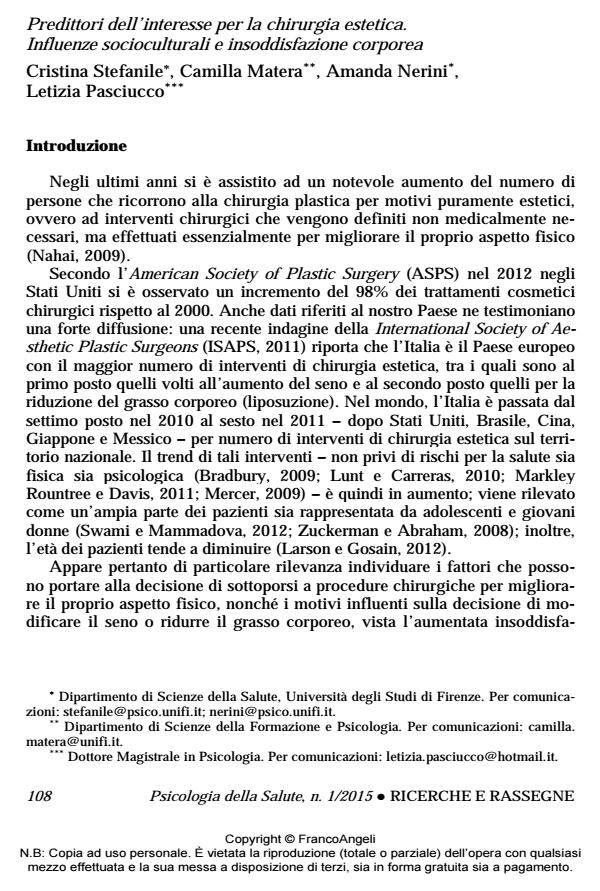Predictors of the consideration of cosmetic surgery: Sociocultural influences and body dissatisfaction
Journal title PSICOLOGIA DELLA SALUTE
Author/s Cristina Stefanile, Camilla Matera, Amanda Nerini, Letizia Pasciucco
Publishing Year 2015 Issue 2015/1
Language Italian Pages 23 P. 108-130 File size 163 KB
DOI 10.3280/PDS2015-001010
DOI is like a bar code for intellectual property: to have more infomation
click here
Below, you can see the article first page
If you want to buy this article in PDF format, you can do it, following the instructions to buy download credits

FrancoAngeli is member of Publishers International Linking Association, Inc (PILA), a not-for-profit association which run the CrossRef service enabling links to and from online scholarly content.
The aim of the present research was to identify psychosocial factors that affect the interest towards cosmetic surgery in general terms and targeted to modify specific parts of one’s body in young women. Participants (N = 203; mean age = 26.70, SD = 3.63) completed a questionnaire in order to assess peer attributions, media pressure, internalization of the body ideals, body dissatisfaction, consideration of cosmetic surgery in general, for breast modeling, and for surgery aimed at reducing body fat. Results suggest that the effects of media pressures and peer attributions on the consideration of cosmetic surgery both in general and for breast modeling are mediated by the internalization of body ideals. With respect to cosmetic surgery aimed at reducing body fat, body dissatisfaction and not internalization seemed to mediate the effect of media pressures and peer attributions. Moreover, peer attributions had also a direct effect on the interest in procedures aimed at reducing body fat. The present study provides an important contribution to understanding the growing interest in cosmetic surgery by the female population. The results may have important implications for preventive and health promotion intervention.
Keywords: Cosmetic surgery, breast plastic, liposuction, abdominoplasty, body dissatisfaction, peer influences, internalization, media pressure.
- Sexual Orientation, Peer Influence, Body Dissatisfaction, and Eudaimonic Well-Being in Italian Men Camilla Matera, Amanda Nerini, Cristina Stefanile, in Frontiers in Psychology 1843/2019
DOI: 10.3389/fpsyg.2019.01843 - Exploring the Links Between Self-Compassion, Body Dissatisfaction, and Acceptance of Cosmetic Surgery in Young Italian Women Amanda Nerini, Camilla Matera, Cristian Di Gesto, Giulia Rosa Policardo, Cristina Stefanile, in Frontiers in Psychology 2698/2019
DOI: 10.3389/fpsyg.2019.02698 - Influenze socioculturali, immagine corporea e chirurgia estetica Cristian Di Gesto, (ISBN:979-12-215-0673-0)
Cristina Stefanile, Camilla Matera, Amanda Nerini, Letizia Pasciucco, Predittori dell’interesse per la chirurgia estetica. Influenze socioculturali e insoddisfazione corporea in "PSICOLOGIA DELLA SALUTE" 1/2015, pp 108-130, DOI: 10.3280/PDS2015-001010